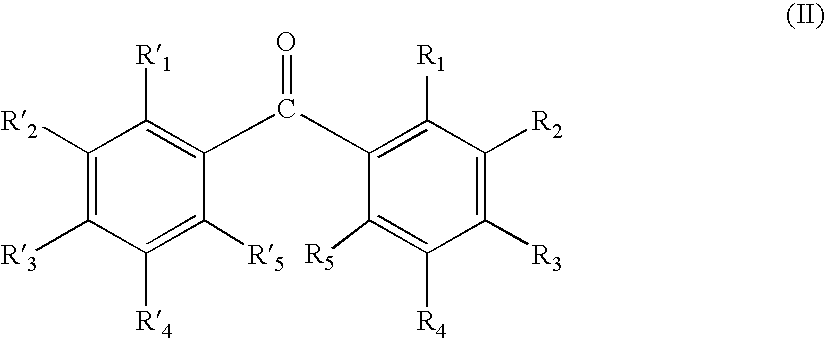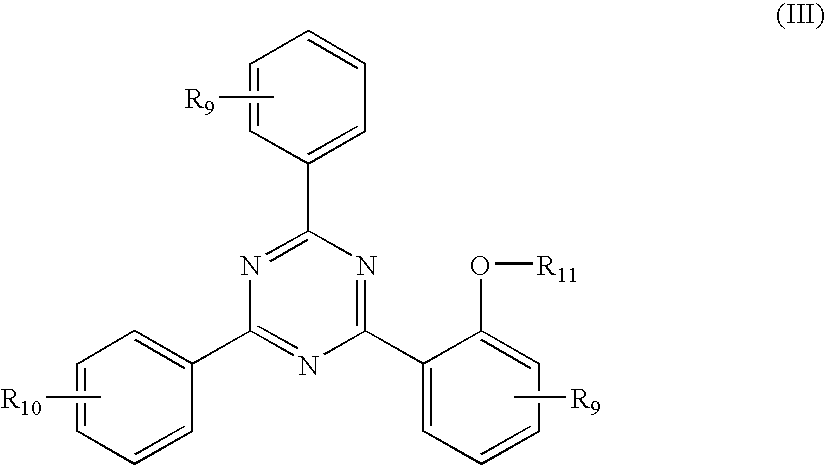Melts
a technology of melts and components, applied in the field of melts, can solve the problems of non-curable melts, and achieve the effects of reducing the chance of thermal degradation of components, convenient removal, and efficient treatmen
- Summary
- Abstract
- Description
- Claims
- Application Information
AI Technical Summary
Benefits of technology
Problems solved by technology
Method used
Image
Examples
example 1
Inkjettable Compositions
[0068]The table below discloses seven examples of inkjettable compositions.
Formulation1234567PolymersPolyethylene glycol MW =94.5 wt %56.7 wt %66.15 wt %56.7 wt % 54 wt %950-1050Polyethylene glycol, MW =1305-1595Polyethylene-co-polyethylene37.8 wt %37.8 wt %37.8 wt % 36 wt %glycol, MW = 1750Polyethylene-co-polyethylene94.5 wt %56.7 wt %glycol, MW = 920Polyethytlene-co-polyethytlene28.35 wt %glycol, MW = 875UV / Visible Absorbers2-isopropylthioxanthone + 4- 5 wt % 5 wt % 5 wt % 5 wt % 5 wt %4.762 wt %isopropylthioxanthone4,4′- 5 wt %bis(diethylamino)benzophenoneAntioxidantsOctadecyl 3,5-di-t-butyl-4- 0.5 wt % 0.5 wt % 0.5 wt % 0.5 wt % 0.5 wt % 0.5 wt %0.476 wt %hydroxyhydrocinnamateAcid / AnhydrideGlycolic acid4.762 wt %Viscosity (centipoise)110° C.14.2120° C.19.312.118.418.212.919.122130° C.10.9
[0069]All seven formulations were prepared by the same method. The polymers were first melted to form a liquid or a viscous semi-solid. The remaining components w...
example 2
Inkjetting a Formulation
[0071]Formulation 5 from the table in Example 1 was inkjetted from a piezoelectric drop-on-demand printhead (Spectra Apollo) onto copper panels with soldermasks. The temperature during inkjetting was 125° C. Drops of an average of 35 nanograms exited the printhead at an average velocity of 6.5 m / s. The velocity was measured with a conventional drop watcher. Formulation 5 was suitable for use with a conventional drop-on-demand inkjetting apparatus.
example 3
Light-Attenuating
[0072]An acrylic / epoxy soldermask having the formulation:
Component% Wt.Tris(2-hydroxyethyl) isocyanurate triacrylateMethylated melamine18.7Hetron 912 (epoxy methacrylate resin)3.4Novacure 3701 (diacrylate ester of a bisphenol A epoxy resin)6.2Epoxy cresol novolac resin, epoxy eq. 23523.8Bisphenol A epoxy resin, epoxy eq. 575-68523.35-(2,5-dioxotetrahydrofuryl)-3-methyl-3-cyclohexene-1,2-8.6dicarboxylic anhydride2,2-dimethoxy-2-phenyl acetophenone1.42-methyl-1-[4-(methylthio)phenyl]-2-(4-morpholinyl)-1-6.2propanoneisopropylthioxanthone2.3100.0PLUS Additives:Modaflow0.9Byk 361, 306 (equal portions)0.8Pigment (Penn Green)1.0Filler (Cabosil EH5, fumed silica)1.5Inhibitor (MEHQ)0.1Solvent (Amount and type appropriateto the method of application)Solvent used: Ethyl-3-ethoxy propionate (EEP)
was deposited on each of 10 mechanically-scrubbed copper panels and then dried at 77° C. for 40 minutes until the soldermask on each panel was tack-free. A masking composition having th...
PUM
| Property | Measurement | Unit |
|---|---|---|
| wt % | aaaaa | aaaaa |
| wavelengths | aaaaa | aaaaa |
| temperature | aaaaa | aaaaa |
Abstract
Description
Claims
Application Information
 Login to View More
Login to View More - R&D
- Intellectual Property
- Life Sciences
- Materials
- Tech Scout
- Unparalleled Data Quality
- Higher Quality Content
- 60% Fewer Hallucinations
Browse by: Latest US Patents, China's latest patents, Technical Efficacy Thesaurus, Application Domain, Technology Topic, Popular Technical Reports.
© 2025 PatSnap. All rights reserved.Legal|Privacy policy|Modern Slavery Act Transparency Statement|Sitemap|About US| Contact US: help@patsnap.com



